AP State Syllabus AP Board 7th Class Science Important Questions Chapter 11 Respiration in Organisms
AP State Syllabus 7th Class Science Important Questions 11th Lesson Respiration in Organisms
7th Class Science 11th Lesson Respiration in Organisms Important Questions and Answers
Question 1.
What is breathing?
Answer:
The process by which air goes in and out of our body is called breathing.
Question 2.
What is inspiration and expiration ?Explain the term ‘respiration rate’.
Answer:
- The process of breathing in air is called inspiration and that of breathing out air is called expiration.
- The number of times we breathe in and breathe out air in a minute is called the respiration rate.
![]()
Question 3.
What does our breath contain?
Answer:
- We know that we inhale and exhale air.
- The exhaled air is warm and has moisture in it.
- What we do not know is about the gases our body takes from the inhaled air and throws out in exhaled air.
- We know that air is a mixture of several gases not only Oxygen and Carbon dioxide, there are others as well. Air also contains several suspended particles.
- We inhale all these.
- We exhale Carbon dioxide, Oxygen, Nitrogen and other gases.
Question 4.
How does a fish breathe?
Answer:
- Observe fishes in an aquarium. Fishes continuously open and close their mouth in water.
- Why do the flaps on both sides of the head alternately open and close?
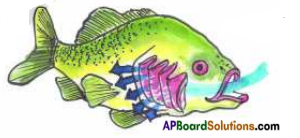
- If you look below the flaps, you will see gills. These are the respiratory organs of the fish.
- The water that enters the mouth flows through both the gills as it comes out of the flaps.
- The gills absorb the oxygen that is dissolved in the water. This oxygen is carried to different parts of the body.
Question 5.
Describe how does a frog take its breathe.
Answer:
- We know that frog is able to stay on land, in water and even underground.
- To breathe on land it has lungs while it goes deep underground and sleeps twice every year, its moist skin takes over the function of its lungs.
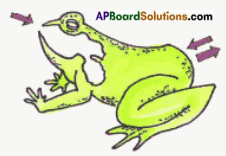
- In baby frogs or tadpoles there are special organs like that of fishes called gills.
- These gills help them to breathe in water by taking in the air dissolved in water.
- Tadpoles of the frog live only in water but the frog lives either on land or in water. Sometimes you may see frogs under the soil also.
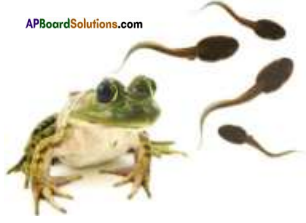
![]()
Question 6.
Explain the breathing process in cockroach.
Answer:
- A cockroach has small openings on the sides of its body.
- Other insects have similar openings.
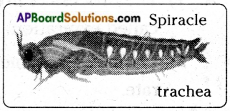
- On the underside of the cockroach in each segment, there are small holes which are connected through respiratory tubes in a network.
- These help the cockroach to breathe. These holes are called spiracles.
- The network of respiratory tubes called trachea take air from these spiracles, circulate it throughout the body, collect it back and send it out through these spiracles.

- To know more about this process you may observe a live cockroach by keeping it covered by a transparent bottle or glass.
Question 7.
Describe how does an earthworm breathe.
Answer:
- Earthworms breathe through their skin.
- It is thin and moist with minute holes.
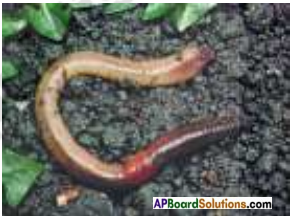
- Through the skin, air passes in and out.
- The earthworm thus breathes through its whole body surface.
Question 8.
How do plants respire?
Answer:
- In human beings gaseous exchange with the surroundings takes place through nose and mouth.
- We know the parts in plants that help in gaseous exchange.
- They are stomata present on surface of leaves and lenticels present on the surface of stems.
- They respire through them.
![]()
Question 9.
At what time plants respire and photosynthesize?
Answer:
- In day time plants respire as well as photosynthesize.
- At night only part of the process of photosynthesis takes place and carbon dioxide is not used up completely by this process.
- Respiration continues at night also.
Question 10.
What is use of oxygen in hospitals?
Answer:
- You may have heard of big hospitals keeping cylinders filled with oxygen.
- When a person has breathing problems he is given oxygen.
- An oxygen mask is fitted to the nose and mouth of the person and a rubber tube connects the mask to the oxygen cylinder.
- Sometimes a patient is given oxygen during an operation.
Question 11.
In your opinion does the expiration rate increase or decrease after exercising?
Answer:
- The air we breathe in fills our lungs that are located in our chest.
- Exercise and running increase the rate of our breathing.
Question 12.
What happens to your chest when you take a breath?
Answer:
- Take a length of twine or a measuring tape. Wrap the tape around the chest of one of your friends and measure the width of her / his chest.
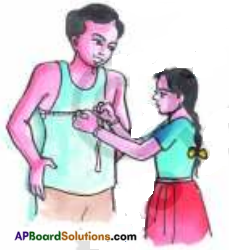
- Hold the tape lightly and ask your friend to breathe in and out deeply a few seconds.
- You find that the chest expands when air is inhaled, it reaches the lungs and chest expands.
Question 13.
What is the difference between inhaled and exhaled air?
Answer:
- Exhaled air is warm and contains moisture and carbon dioxide.
- Inhaled air is at room temperature and contains oxygen along with other gases.
![]()
Question 14.
How long a person can hold his / her breath? How do you find?
Answer:
- Use a watch with a seconds needle to time our breathing.
- If we don’t have a watch, then practice counting at a uniform rate.
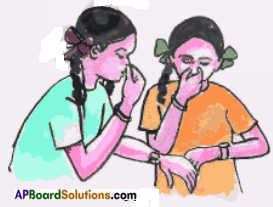
- We can measure the time by counting.
- Close our mouth and close our nose with our fingers so that air cannot pass through it.
- We can find the time for how long could we keep our mouth and nose closed.
Question 15.
How many breathes do you have in a minute?
Answer:
- Hold a finger under the nose of one of your friends.
- The side with the fingernail should face the nostrils.

- Ask your friend to breathe in and out normally.
- When your friend exhaled your finger felt the warmness of the air.
- Using this method you can find out how many times your friend inhales and exhales in a minute.
Question 16.
How much air do you breath? Do a simple activity to know it?
Answer:
- Make a measuring cylinder with a two-litre plastic bottle and 100 ml injection bottle.
- To do this, pour 100 ml of water at a time in the bottle and mark the water level after each addition.
- Now fill the bottle to the brim and invert it in a bucket or a large container of water.
- But remember, no air bubbles should remain in the bottle after you invert it.

- Insert one end of a rubber tube into the mouth of the bottle under water.
- Hold the other end of the tube in your hand. Inhale as much air as you can and blow the air into the measuring cylinder through the rubber tube.
- Don’t breathe in while blowing the air out.
- Blow out as much air as you can in a single breath.
- This air will collect in the measuring cylinder.
- As a result,-the water level in the cylinder will fall.
The reduction in water level is equal to the air you breath.
![]()
Question 17.
How do you find the gases that are present in our breath? Describe the activity you perform.
Answer:
- Set up the apparatus shown in Figure (a) for this experiment. Be careful while inserting the glass tube in the cork. It could break. So take the help of your teacher to do this.

- Fill both boiling tubes one fourth with phenolphthalein solution. Mark them A and B.
- Now repeatedly blow in and suck out air in this apparatus as shown in Figure (b).

- Note the boiling tube in to which air flows when you suck in air.
- Note the boiling tube through which air flows out when you blow out air.
- You find that there is a difference between inhaled air and exhaled air.
- Repeat the experiment by replacing the boiling tubes with lime water filled one fourth in them.
- You will find that the lime water in the tube through which exhaled air passed turned milky.
- This indicates that the exhaled air contains carbon dioxide.
- The table given here under shows the components in the inhaled air and exhaled air.
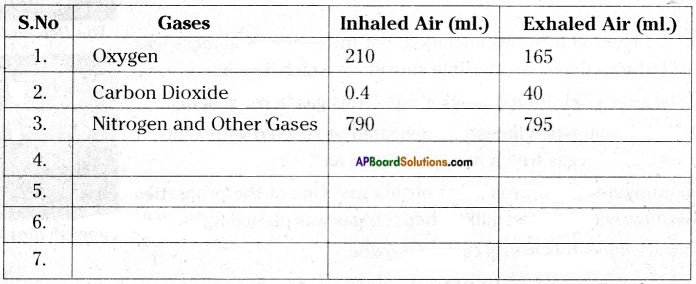
Question 18.
How can you find out the respiration in plants by an experiment?
Answer:
- Take a conical flask. Fit a two-holed rubber cork tightly into its mouth and insert glass tubes into the two holes.
- Fit a rubber tube on one of the glass tubes and a funnel on the other. If the funnel does not sit tightly on the glass tube, make a funnel with an ink dropper.
- Fill a test tube about one-fourth with lime water and dip the rubber tube into it.
- Now add water to the funnel drop by drop. Keep adding water till the conical flask is filled one-fourth with water. Observe the test tube carefully while you add water.
- You find no change in the colour of lime water.
- Now remove the water from the conical flask and put some flowers and buds in it. Fit a cork on the flask and let it stand for half an hour.
- Now add water drop by drop to the conical flask through the funnel as you did in the previous experiment. Look carefully at the test tube while doing so.
- The lime water turns milky indicating the release of carbon dioxide.
- This is how plants respire. They take oxygen and release carbon dioxide.
![]()
Question 19.
How do you find respiration in sprouted seeds?
Answer:
- Take sprouted seeds is the conical flask.
- Pour water drop by drop in to the funnel through the funnel.
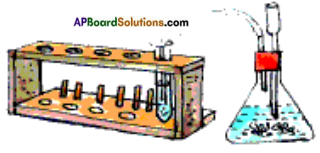
- The released gases are allowed to pass through lime water.
- Lime water turns milky indicating the release of carbon dioxide.
- Sprouted seeds respire taking oxygen and releasing carbon dioxide.
Question 20.
Write a note on the discovery of carbon dioxide.
Answer:
- The first step towards trying to find out what air contained was carried out by Von Helmont.

- He conducted an experiment of burning charcoal which leads to the formation of ash.
- He found the weight of ash to be much less as compared to charcoal.
- On the basis of this, he concluded that the decrease in mass was due to the formation of an invisible substance which he named “gas”.
- In the year 1756, Joseph Black studied this gas in more detail.

- He found that when limestone is heated or reacted with acids, it gives rise to a gas which he called “fixed air”.
- He studied several properties of this gas. One of the properties was, lime water turned milky when this gas was passed through it.
- Now we know this gas as carbon dioxide.
![]()
Question 21.
How is oxygen discovered? Write the history of its discovery.
Answer:
- After nearly two decades of discovery of carbon dioxide, oxygen was discovered.
- Joseph Priestley, published his“Experiments and observations on different kinds of air” and was the first to prove the different qualities of the gases released by plants and the one’s exhaled by animals (mice).

- He discovered that, although a candle burned out in a closed container, when he added a living sprig of mint to the container, the candle would continue to burn.
- At the time, Priestley did not know of Oxygen, but he correctly concluded that the mint sprig “restored” the air that the burning candle (or mice which he used in a similar set of experiments) had spoiled.
- Priestley shared his observations with Lavoiser.

- Lavoiser had also conducted several experiments on atmospheric air and knew that it contained many gases, and he identified Priestley’s discovery as the active component of air for which he had been searching.
- He called it oxygen (Greek: acid former), in the belief that all acids contained it.
Question 22.
Do plants respire?
Answer:
- Plants respire like us.
- But it is difficult to observe this through experiments.
- Both plants and animals use oxygen during respiration.
Question 23.
Read the table and answer the following questions.
| Respiratory organ | Name of the organism |
| Gills | Fish, Tadpole |
| Skin | Frog, Earthworm |
| Trachea | Scorpion, Cockroach, Grasshopper |
| Lungs | Frog, Hen, Man |
- Which animals respire through the trachea?
- Why does fish respire only in water?
- In how many ways does frog respire?
- Give some more examples for animals that respire with lungs.
Answer:
- Scorpion, Cockroach, Grasshopper.
- Gills are the respiratory organs of the fish. The gills absorb the oxygen that is dissolved in water. Hence, fish respire only in water.
- Gills, Lungs, Skin.
- Frog, Monkey, Man.
![]()
Question 24.
Name the respiratory organs of the following animals,
a) Fish b) Earthworm
Answer:
a) Fish ——– Gills.
b) Earthworm ——– Skin.
Question 25.
Read the table. Answer the questions given below.
| Gases | Available in Inhaled gas (ml) | Available in Exhaled gas (ml) |
| Oxygen | 210 | 165 |
| Carbon dioxide | 0.4 | 40 |
| Nitrogen | 790 | 795 |
a) Which gas is more in inhaled air?
b) What changes do you observe in the percentage of carbon dioxide in the exhaled air? Where does it come from?
c) How much Oxygen is retained in our body?
d) Which gas is more useful in our respiration process?
Answer:
a) Nitrogen
b) The volume of carbon dioxide is increased. CO2 is released during respiration.
c) 45 ml
d) Oxygen.
Question 26.
Latha’s teacher conducted an experiment in the classroom. Look at the picture and answer the following questions.
- What is the aim of this experiment?
- Which equipment is required to conduct this experiment?
- Which gas is released during the experiment?
- What other material can be used in this experiment instead of seeds?
Answer:
- To prove that respiration takes place in plants.
- Conical flask, a two-holed rubber cork, test tube, funnel, rubber tube and lime water.
- CO2 (Carbon dioxide)
- Moong, Bengal gram.